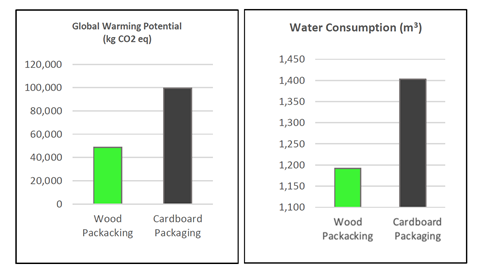Wooden packaging was found to outperform corrugated cardboard in a Life Cycle Assessment, especially in terms of greenhouse gas emissions, ecotoxicity, food safety and water footprint
Wooden packaging has a lower environmental impact than its corrugated cardboard counterpart, according to the results of a Life Cycle Assessment (LCA) performed by consulting firm Géminis Tools, in collaboration with researchers from the group of Information and Communication Technologies against Climate Change of the Universitat Politècnica de València.
The LCA compared the performance of the two kinds of single-use packaging for the refrigerated transport of 1,000 tonnes of mandarins by truck between Valencia and Germany, a distance of 2,000km.
The higher energy consumption required to recycle paper and cardboard, the greater water consumption needed in the recycling and manufacturing process and the use of chemicals during recycling make wooden packaging more attractive in terms of emissions, water consumption, water eutrophication and terrestrial acidification, the study concluded.

Fedemco, the Spanish Federation of Wooden Packaging and its Components, said that the European wood industry was leading the way in achieving circularity and carbon neutrality through “resource efficiency, circular design, prioritising recycling over early energy recovery through cascading”.
The federation has developed and is promoting the European Ecowoox mark that certifies the eco-design and total recyclability of wooden packaging to meet national and European regulatory requirements.
“The use of wooden packaging is a great advantage in the refrigerated transport of fruit and vegetable products, as it preserves better the properties of the transported product due to its resistance and strength,” Fedemco added. “Its physical and mechanical properties stand out, as well as the protection it provides to the product against changes in the hygrothermal conditions of the environment. The use of wood in this type of packaging is beneficial for promoting sustainable forest management and the rural economy, especially in the Mediterranean forests where the raw materials, mainly pine and poplar, come from.”



